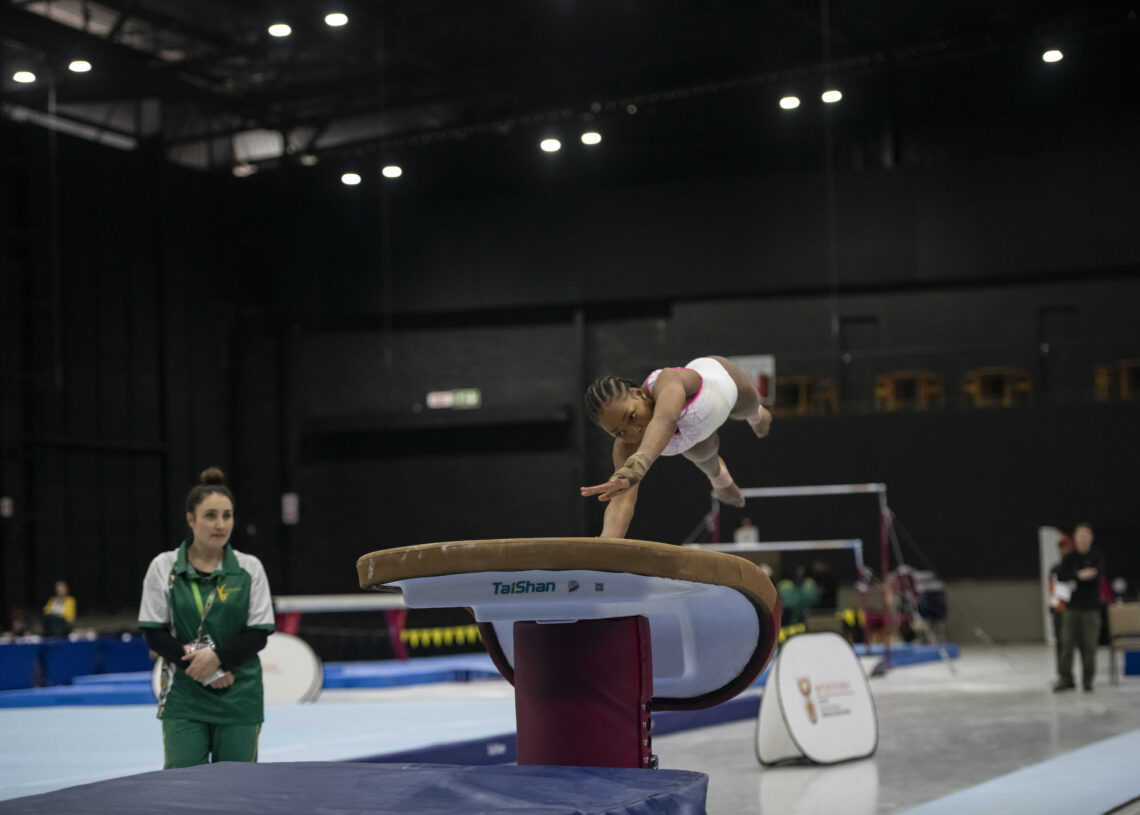As the 2025 FIG World Gymnastics Championships open in Jakarta, South African Gymnastics Achievements come into sharp focus through two compelling stories, a debut that signals the future and a historic sixth appearance that defines longevity. In a field stacked with global talent, South Africa’s Buhle Nhleko and Naveen Daries carry momentum, purpose and the kind of quiet courage that reshapes expectations back home.
Buhle Nhleko brings quiet confidence to her first Worlds
At 20, Buhle Nhleko steps onto the sport’s biggest stage with a mindset rooted in learning and growth. She arrives in Jakarta on the back of an important tune-up at the World Challenge Cup in Paris, where she banked valuable competitive reps and feedback that will inform her routines this week.
In Paris she competed on vault and floor, finishing inside the top 16 on vault with 12.750 and adding 10.466 on floor. Those numbers are more than line items, they are building blocks for a gymnast intent on translating lessons into cleaner, more confident execution in Jakarta.
From Paris to Jakarta building on vault and floor
Before departing for Worlds, Nhleko framed Paris as both preparation and opportunity.
“Paris was both preparation and opportunity,” she explained. “The goal is to focus on being the best I can possibly be and to improve on my last scores with clean, confident routines.”
It is a measured, process-first approach, the kind that tends to travel well from one competition to the next.
That approach shows in how she talks about her craft. Precision and composure carry as much weight as difficulty, and the emphasis is on making each turn count. It is a template that, if sustained, can turn a first Worlds into a springboard for seasons to come.
Representing South Africa with purpose
Nhleko’s goals are bigger than personal bests. She has spoken openly about visibility and access, the two levers that influence how young athletes discover and stay in gymnastics in South Africa.
“In South Africa there’s not much exposure when it comes to the sport,” she said. “We have so much talent, but without exposure, opportunities are limited.
Competing on a stage like Worlds becomes a message to aspiring gymnasts that the pathway is real and reachable, especially when they see someone from their own communities finding a lane to the top level.
Her sense of purpose fits a wider movement within the national program, one that treats international appearances as both competitive targets and storytelling platforms. That twin focus, performance and inspiration, is quietly expanding the sport’s footprint at home.
Balancing difficulty and wellbeing
Team South Africa has intentionally raised routine difficulty step by step, never losing sight of execution. For Nhleko, training is as much about recovery as repetition, a philosophy that prizes durability.
“It’s all about trusting the process,” she explained. “You have to build recovery into your training just as much as the work itself.
That balance, the marginal gains and the recovery, is often the difference between surviving the season and thriving in it.
It also reflects maturity that belies her years. She is speaking the language of experienced elites, where careful planning helps protect the body while the mind stays aligned to the next skill, the next meet, the next chance to refine.
Backed by experienced teammates and coach
This first Worlds does not feel isolating for Nhleko, and that matters. She is part of a core trained by coach Ilse Pelser at the JGC Gymnastics Club in Johannesburg, alongside Olympians Caitlin Rooskrantz and Naveen Daries. That daily proximity to major event experience is a competitive advantage that will steady her in Jakarta.
Nhleko has talked about how well the group understands one another, from knowing when to give space to knowing when to lift the energy around the apparatus. The support system is a safety net and a spring, both crucial in an environment where every routine turns on details and nerve.
Embracing Indonesia and the moment
There is joy woven through Nhleko’s anticipation. She is grateful for the opportunity and unafraid to admit the thrill of a first trip to Indonesia.
“I’m incredibly excited, so grateful and thankful for this opportunity,” she said. “I hear it’s warm there too, I’m looking forward to that.”
It is simple, human, and disarming, the kind of honesty that makes fans lean in.
When she salutes the judges, she will bring Paris lessons, a trusted team, and a promise to herself to deliver the routines she has trained. For a debutant, that is the truest definition of success.
Naveen Daries etches a new line in South African history
When the apparatus lights up in Jakarta, Naveen Daries will stand at the edge of a milestone that no South African woman has reached before. This is her sixth FIG Artistic Gymnastics World Championships, a run that began in Montreal in 2017 and continued through Doha 2018, Stuttgart 2019, Liverpool 2022 and Antwerp 2023.
The arc is remarkable, not only for its length but for its steady rise. Her résumé spans national titles, African medals and World Cup finals, and in 2021 she secured a continental berth to the Tokyo Olympics with bronze at the African Championships. That kind of durability says as much about her character as any score sheet.
A journey defined by perseverance and progress
Daries has never presented herself as untouchable. She has been candid about a vision impairment in her right eye, a factor that could complicate release moves on uneven bars. Over time she has honed spatial awareness and instinct, trusting muscle memory to carry her through the most exacting elements.
The innovation is in the adaptation. She has turned a potential limitation into part of her competitive identity, proof that the sport’s biggest tests are as much mental as physical.
Paris as prelude to Jakarta
In the build-up, Daries approached the World Challenge Cup in Paris as a staging ground, a place to rehearse difficulty and execution before Worlds.
“Paris is just more like a stepping stone for me. And so is Worlds, actually … the important trials is in December … both are stepping stones for that trial at the end of the year.”
The clarity is striking, she is plotting a season, not just a single meet.
There were encouraging signs in Paris. Her vaulting returned 12.700 and 12.866 for an average of 12.983, and she posted 11.633 in qualification on bars. The incremental gains on difficulty, especially on bars, underline her determination to keep pushing her ceiling.
Mindset, mentorship and faith
Daries’s reflections in her final training session before departure offered a window into how she sustains form and joy.
“I will be taking a week in Bali with my family,” she shared. “It will be active rest … then back in the gym, really work hard for trials.
After Jakarta, the calendar points to December, then team targets at African Championships and Commonwealth Games, a sequence that keeps her anchored in the day to day.
She also spoke about community across borders and how friendships soften the grind.
“Sometimes you feel like you’re the only one struggling, but then you realize … there’s people that are high up, they also struggle … I have close friends from different countries … one helps me with dismounts, we chat often … she’s a vet … she’s a massive role model to me … She adds, laughing: I feel very old because I’m the only one that has done six world championships … I just thank God for allowing me to go on for so long … to keep going and to keep working hard.”
It is humility and perspective, qualities that tend to show up when the pressure peaks.
What Jakarta means in a changing format
This edition in Jakarta follows a fully individual structure, with no team event on the program. Under updated FIG regulations, national federations may bring up to four female gymnasts, with up to three per apparatus, and a total of 86 nations are registered.
For athletes like Daries and Nhleko, the format spotlights personal campaigns and apparatus specialization. It also raises the value of every routine, since each one stands alone without the cushion of a team score.
Why these stories matter for South African gymnastics
Visibility matters, and so does continuity. In one week, South Africa celebrates a first World Championships for Nhleko and a sixth for Daries, a pairing that captures both horizon and heritage. The effect at home could be profound, young gymnasts can see two paths unfolding at the same time.
Nhleko’s message about exposure meets Daries’s message about perseverance, and together they suggest a template for the next wave. The presence of Olympians in the training gym and a coach like Ilse Pelser guiding the group at JGC Gymnastics Club creates a culture where experience is shared and ambition is normalized.
What to watch for in Jakarta
- Nhleko’s vaulting after a top 16 in Paris and the refinement of her floor routine,
- Daries’s bars composition and vault average as indicators of her difficulty push,
- The individual-only structure that allows up to four women per nation, with up to three per apparatus.
The heartbeat of a landmark week
The poetry of this moment lies in its balance. A newcomer like Nhleko brings fresh energy and possibility, while a standard-bearer like Daries offers proof that a South African career can stretch across cycles, continents and formats.
Jakarta is the gathering point where those trajectories intersect with the world’s finest. For Nhleko, the aim is to do what she does in training, to stack clean turns and take another step. For Daries, the aim is similar, to keep evolving, to treat each competition as one page in a longer story.
A closing thought on legacy and momentum
There is a quiet revolution underway, written in small increments and sustained by community. The strides in Paris, the hours in the JGC gym, the belief that recovery and repetition can coexist, these are the threads that connect debut to dynasty.
As the scoreboard flickers in Jakarta, the deeper scoreboard is already changing in South Africa. More young athletes will see the sport on television and on their phones, more parents will recognize the pathways, and more coaches will point to examples that look and sound like home. That is the essence of progress, performance that opens doors for those who come next.
South Africa’s message to the mat
It is simple and powerful, be brave enough to start and stubborn enough to continue. In Jakarta, Buhle Nhleko and Naveen Daries embody both halves of that sentence, and in doing so, they carry South African gymnastics into a new chapter.






